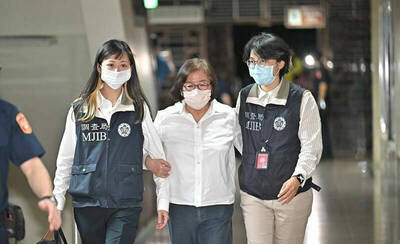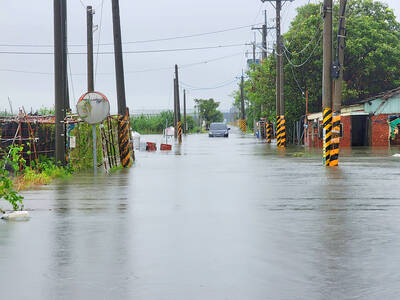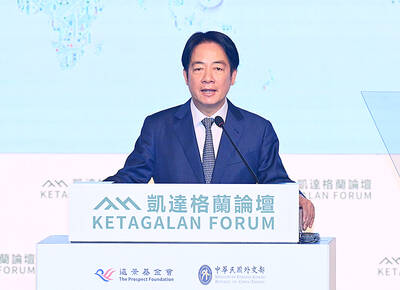Technical proficiency is no substitute for a good yarn, and whatever else the CKS Cultural Foundation’s flagship production of Mackay — The Black Bearded Bible Man (黑鬚馬偕) that premiered at the National Theater this weekend may be, it never develops into a gripping story. Rather than an amazed meander through the bizarre coincidences that made a Presbyterian missionary from Canada a cultural icon of Taiwan’s development, it plods through the main events of George Leslie Mackay’s life with the humorless determination of a schoolteacher preparing students for an exam.
The profoundly constricted conception of what can only be described as a hagiography of Mackay undermines every other quality of the production. That Mackay dedicated his life to Taiwan and was a conscientious missionary is an undisputed fact, and that he loved Taiwan and its people is more than probable, but these points are labored to the exclusion of virtually all other ideas, unnecessarily underscoring an ideological motivation for the creation of this opera. Mackay emerges as a cardboard cutout, and while the opera follows him quite literally from birth to death, this presentation of his life achieves neither operatic grandeur nor emotional depth. His reflections on the beauty of Taiwan seemed to have been cribbed from some of the more egregious publicity material published by the Government Information Office for the consumption of tourists. Even an extended scene in which Mackay comes into conflict with local temples over his medical and religious practices is bland, and one cannot get away from the suspicion that all rough edges have all been smoothed over in the interests of political correctness and the avoidance in the opera of even the slightest suspicion of controversy.
That said, baritone Thomas Maglioranza (who plays Mackay) does a sterling job with the thin material that he is given, impressing with his conviction. If his character is flat, then the rest are flatter still (if that is possible), and the strong cast of Asian opera talent is unable to shine.
The relationship between Mackay and his wife (soprano Chen Mei-ling), a shadowy figure in the history books and an opening for the show’s creators to give their imagination free rein, never really goes beyond idolatry of the great man.
Director Lukas Hemleb must be congratulated for his very creative stage design, using a series of concentric rectangles that form a series of independently articulated platforms and give the stage enormous dynamism. The use of projections, however, was not as successful. Clearly intended to inject an element of historical realism into the show, for the most part they managed to be little more than a distraction. Images of Mackay writing home, one of the many clumsy devices used to reveal the mind of the protagonist and move the story forward, served to cover changes to the set, but I found the fact that he seemed to be using a felt-tipped pen unreasonably annoying.
The opera, which was sung in English and Taiwanese, had subtitles in both Chinese and English. While the presence of English subtitles was definitely welcome, they would have benefited from editing, or at least proofreading, to avoid the numerous typos and basic grammatical mistakes that are unacceptable in such a high-profile international production.
While the production overall showed a high level of proficiency from the performers and the technical staff, as a work of art it didn’t go much beyond the realm of historical propaganda. One couldn’t help feeling sad at how much effort had been lavished on the presentation of a chapter from a junior high school history text. Even the exact amount of money that Mackay raised in Canada for the creation of the Tamsui Oxford College (牛津學堂) is laboriously brought up.
Looked at in the context of the many experimental operas that have been produced in recent years, one can see that the money and the high level support for Mackay — The Black Bearded Bible Man has certainly paid off in the quality of the presentation. What is still missing is a creative sensibility to direct these resources to make something more satisfying than a bald narrative of a worthy life.
Meanwhile, at the German Cultural Center on Tuesday, three times as many people showed up for jazz saxophonist Tony Lakatos as there were seats. He was in concert with three Taipei residents, Chris Stiles (piano), Martijin Vanbuel (bass) and Ed Schaefer (drums). Not sure what to make of the large turnout, or indeed of the show, I consulted some Taiwanese jazz musicians in the audience. Pianist Nathan Tu (杜迺迪) said that Lakatos’s style was essentially bebop, and that the auditorium and its acoustics were ideal for this kind of lineup.
“His technique is intuitive and unhesitating,” said trumpeter Rita Chao (趙彥婷). “His flow of musical ideas is remarkable, and his articulation superb.”
Fellow saxophonist Mark Chen (陳侯杰) found his playing smooth, and appreciated the way he spelled out his chords clearly and exactly. His tonal color was admirable, he said.
Lakatos told me he was on his way to Japan where he’d played more times than he could remember, but that this was his first visit here. His reception, though, suggests he’ll be back again soon.
I left marveling at what the center achieves. Today it was jazz, and last time it was 19th-century German lieder. I’ve heard a cappella and Bavarian zither, and everything attracts a sizeable audience, though rarely as big as Tuesday’s. There are art exhibitions too. No other foreign representative office in Taiwan appears to do anything remotely comparable.

Following the shock complete failure of all the recall votes against Chinese Nationalist Party (KMT) lawmakers on July 26, pan-blue supporters and the Chinese Communist Party (CCP) were giddy with victory. A notable exception was KMT Chairman Eric Chu (朱立倫), who knew better. At a press conference on July 29, he bowed deeply in gratitude to the voters and said the recalls were “not about which party won or lost, but were a great victory for the Taiwanese voters.” The entire recall process was a disaster for both the KMT and the Democratic Progressive Party (DPP). The only bright spot for

Water management is one of the most powerful forces shaping modern Taiwan’s landscapes and politics. Many of Taiwan’s township and county boundaries are defined by watersheds. The current course of the mighty Jhuoshuei River (濁水溪) was largely established by Japanese embankment building during the 1918-1923 period. Taoyuan is dotted with ponds constructed by settlers from China during the Qing period. Countless local civic actions have been driven by opposition to water projects. Last week something like 2,600mm of rain fell on southern Taiwan in seven days, peaking at over 2,800mm in Duona (多納) in Kaohsiung’s Maolin District (茂林), according to

Aug. 11 to Aug. 17 Those who never heard of architect Hsiu Tse-lan (修澤蘭) must have seen her work — on the reverse of the NT$100 bill is the Yangmingshan Zhongshan Hall (陽明山中山樓). Then-president Chiang Kai-shek (蔣介石) reportedly hand-picked her for the job and gave her just 13 months to complete it in time for the centennial of Republic of China founder Sun Yat-sen’s birth on Nov. 12, 1966. Another landmark project is Garden City (花園新城) in New Taipei City’s Sindian District (新店) — Taiwan’s first mountainside planned community, which Hsiu initiated in 1968. She was involved in every stage, from selecting

As last month dawned, the Democratic Progressive Party (DPP) was in a good position. The recall campaigns had strong momentum, polling showed many Chinese Nationalist Party (KMT) lawmakers at risk of recall and even the KMT was bracing for losing seats while facing a tsunami of voter fraud investigations. Polling pointed to some of the recalls being a lock for victory. Though in most districts the majority was against recalling their lawmaker, among voters “definitely” planning to vote, there were double-digit margins in favor of recall in at least five districts, with three districts near or above 20 percent in